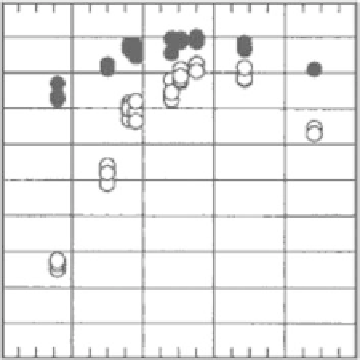Biomedical Engineering Reference
In-Depth Information
is normally required for composites to maintain transparency. Besides a resin RI varies
with temperature. The impacts of temperature and RI on the nanocomposites trans-
parency were thus first evaluated for high fiber content (60% BC) nanocomposites (14).
A series of acrylic resins with RI ranging from 1.492 to 1.636, close to the cellulose
RI, 1.544 in the transverse direction and 1.618 in the longitudinal direction, was used
to manufacture various BC/acrylic nanocomposites. Again less than 10% degradation
in luminous transmittance was observed in the nanocomposites compared to the neat
resins. At 20
◦
C, the total transmittance of the nanocomposites only slightly varied with
RI while remaining above 85% (Figure 9.3). The regular transmittance showed a more
pronounced variation while also remaining above 75% (Figure 9.3). Both the total and
regular transmittances appeared to peak at a RI around 1.56-1.60 which was consistent
with the average RI of BC (Figure 9.3). Although the RI of an acrylic decreased signif-
icantly upon heating to 80
◦
C, no loss in the regular transmittance of the nanocomposite
was observed (Figure 9.4). The relative insensitivity of the nanocomposite transparency
on resin RI and temperature are additional positive attributes of high fiber content BC
nanocomposites as electronic displays.
Nogi's group also expected the nanocomposites optical transparency and the CTE
to depend on fiber content and therefore embarked on evaluating BC nanocomposites
having a much wider variation of fiber content (15). In that objective, the manufacturing
process of the dry BC sheet was altered such that the interstitial space or void in the mat
could be tailored. Two manufacturing procedures were used. In the first procedure, BC
pellicles were first pressed to remove excess water yielding mats with 1/3 void content
90
88
86
84
82
80
78
76
74
72
70
1.46
1.50
1.54
1.58
1.62
1.66
Resin refractive index
Figure9.3
Total transmittance(filledcircles)andregular transmittance(opencircles)ofBC
nanocomposites at 20
◦
C and 590 nm versus the refractive index of their resins at 20
◦
C
and589.3nm. (Reusedwithpermission fromMasayaNogi, KeishinHanda, AntonioNorio
Nakagaito, andHiroyukiYano,Applied Physics Letters,2005, 87, 243110,Copyright2005,
AmericanInstituteofPhysics.)

Search WWH ::

Custom Search